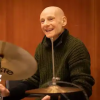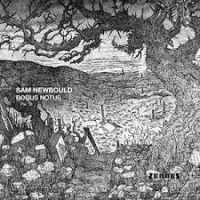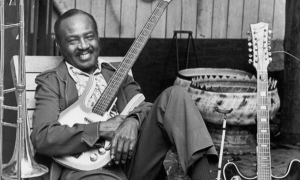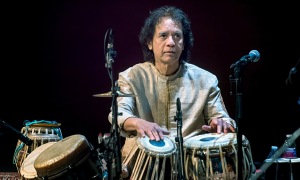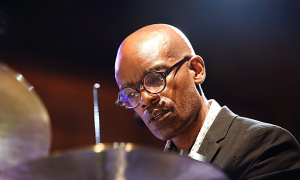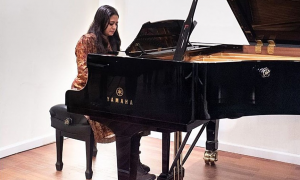Home » Jazz Articles » Under the Radar » A Different Drummer, Part 2: Royal Hartigan
A Different Drummer, Part 2: Royal Hartigan

Courtesy Sara Pettinella
By living the music in Ghana, as well as the Philippines, China, and other communities, I sense ways to bring the elements of rhythm, time cycles, drum and gong tones and timbres, phrases, and forms to the drum set.
—Royal Hartigan
Drums of Life—Drums of Death
The ruins of the Anasazi people stand undisturbed in the cliffs between the high mesas and the canyon floors of the southwest. Dating to 2500 B.C., the multi-story adobe pueblos and stone cities were the sites of the ancient indigenous peoples of North America. Archeologists have uncovered an assortment of percussion instruments in the ruins: suspended stones that resonated when struck, gourd rattles with seeds inside. Rasps were pieces of wood or bone with serrated edges that may have had a musical function similar to a washboard. The later Pueblo people of the region used drums carved from aspen, cottonwood, and pine trees. The heads were elk, buffalo, or deer hides. The Kiowa, Navajo, Zuni, Hopi, and Taos people who still make Pueblo log drums say they represent all life; the heartbeat of Mother Earth.In Ghana, the West African tribes of the Ashanti and Ewe use a master drum to lead the celebrations of death. In acknowledging loss, the ceremonies also recognize that the departed has become a spiritual guide for advice and comfort to the living. The guidance is channeled through the communications of the drum. Villagers dance to the drums of death, and in the festivities, mourning drifts away with the rhythm. The drums are a signal of an ending and beginning, a reminder of the cycle of life and death that revolves around the single unity of spirit. The master drum family is broad and fluid. It includes the "sogo" and its smaller alternative, the "kidi." It can be played with two wooden sticks, one hand and one stick, or both hands and produces a low tone. The Ewe "atsimevu" is more than four feet in height, played much like the kidi but making a middle range sound with some bass. The "agboba," "kloboto" and "totodzi" are other, less frequently used master drums. Bell instruments—gankogui and atoke—and the axatse rattle are also used in the ceremonies. New Orleans jazz funerals, and the more buoyant Second Line parades, can trace their roots to traditional Ghanaian funeral drumming.
In the West African and Cuban religion of Santería, the drum is held in such high esteem that its players first prostrate themselves in front of the instruments in a show of respect. The ceremony is believed the only way to open the door to the ancestors beyond. Chinese drums have been used in celebration and battle. Often painted red for combat, the color of the drum was believed to be a mark of strength in battle. Large two-headed Tàigǔ drums and later, medium-sized Tanggu drums emitted the sound of rolling thunder, frightening adversaries into retreat. In the sixteenth century, the Moghul Emperor Akbar mounted eighteen pairs of kurgas—exceptionally large kettle drums—on elephants and twenty pairs of slightly smaller naggara drums on other animals. Their function was to warn villagers of impending raids. War drums of India, such as the dundhubi, were treated with sacred oils and prayed to before battle. The massive bhoomi dunhubi was made by digging a large hole in the ground and covering it with a hide. It was used in a rite performed at the winter solstice to pray for the sun's return. In the southern Philippines, healing rituals are accompanied by the kulintang, eight horizontally laid, knobbed gongs that lead an ensemble of players. The taiko drummers of Japan played in harvest festivals originated by Buddhist monks. The drumming was a tribute to the gods who assured a productive crop.
Drumming has a global role in life and afterlife rituals; birth, coming of age, social activities, dance, games, religion, hunting, farming, war, and healing. Some have their sophisticated cross-rhythms and polyrhythms; others are simple, primal. Royal Hartigan's scholarship and practical experience have been achieved through immersion in many cultures, particularly in West Africa. He brings a unique understanding of music and its cultural significance to his composing, playing, and teaching. In March, 2021, I interviewed Hartigan on a broad range of percussive and philosophical topics.
Royal Hartigan
American multi-instrumentalist Royal Hartigan has studied, taught, and lived in Africa, Asia, South America, and Europe. As a percussionist, he has explored the percussion cultures of Ghana, the Philippines, China, Korea, Trinidad, and Java, collaborating with native masters. Hartigan has played jazz festivals on four continents, and thirty years ago, he founded the Blood Drum Spirit ensemble releasing four double CDs. He has recorded with Bobby Bradford, Hafez Modirzadeh, Ken Filiano, Fred Ho, Talking Drums, Rudresh Mahanthappa, and many others.Hartigan was a Fulbright scholar to the Philippines and Ghana, and he has written five books and produced an award-winning film, We Are One. He has facilitated educational residencies, workshops, and lectures at institutions and universities across the U.S. and abroad, including the China Conservatory, the University of Ghana, Nagoya Yamaha Japan, and the University of the Philippines. Hartigan was a professor at UMass Dartmouth from 1999 to 2018 and taught at San Jose State University, the New School, and Wesleyan. He received his Ph.D. from Wesleyan in 1986.
AAJ: You were strongly influenced by the rhythmic sensations of your mother and uncle, who were both tap dancers. On Ancestors (Innova Recordings, 2010) you pay homage in direct ways. You tap to the saxophone accompaniment of Hafez Modirzadeh on two tracks, to C. K. Ladzekpo's dondo hourglass drum, on another, and perform two additional tap duets. You also solo tap on "Waltz Clog," "New York Rhythm," and "Walking Step." It's a significant amount of music dedicated to tapping. With its Irish and West African roots, can you talk about how and where tap-dancing fits into the world of percussion?
Royal Hartigan: I believe tap dancing is unique as an expression through movement, musical sound, visual design, and, as an African American art form, improvisation, both as a solo style and in conversation with instrumentalists, vocalists, other dancers, poets, and many diverse disciplines. It also has strong Irish roots and shows how the dance and art from two distinct peoples can come together to create one of the most powerful global styles.
My uncle, Ray Hart (stage name; his actual name is the same as mine; 1887-1964) was an example of this cross-cultural interaction, having danced with many greats, such as Peg Leg Bates, the Nicolas brothers, and the Step brothers. He knew Bill Robinson and many of the legends. Ray toured across the world and the U. S. and told me about many interesting events in his travels: dancing on New York sidewalks to pay his rent, performing with jazz musicians (with the advice to me of always playing at low volume under the sound of the dancers), teaching the children of Flo Ziegfeld in Hollywood, a touring partnership with Cliff Edwards (aka 'Ukulele Ike'), and after retirement, teaching generations of students in the Berkshires, in western Massachusetts. My mother, Hazel Clark Gay-Hartigan, studied with him and became so accomplished that they danced as a team throughout New England and eastern New York state after his retirement. She met my dad, Ray's brother Jim, and also taught with Ray. They mostly used jazz recordings for their tap classes, Erroll Garner, Nat King Cole, Duke Ellington, Fats Waller, George Shearing, among others. So jazz was a near-constant sound in my life.
In my studies of West African music and dance, I see and have performed many dance movements that, if taps were added, are similar, and in some cases, exact ancestors of the wonderful movements of tap dancers. One example is the Bewaa (BAY-wah) harvest dance drumming of the Dagara (dah-GAH-rah) people of northern Ghana. It has many slides, jumps, and foot-leg-hip-torso-arm-body movements that are exactly like those I see in tap.
My teacher and mentor Ed Blackwell told me his sister was an accomplished tap dancer, and when I visited New Orleans following his death, I met her and she brought me to many of the places where Mr. Blackwell grew up and played.
AAJ: You began playing both drums and piano at the age of eight. While you still play and record on piano occasionally, you primarily work as a drummer/percussionist. At what point did you decide to focus on drums?
RH: Yes, I love tap, piano, and drums all equally. When I was at UMass Amherst with Max Roach, Reggie Workman, and Archie Shepp in the 1970s, I felt it was best to focus on one instrument, and chose drums, as I had been working primarily with Mr. Roach.
AAJ: You served in the Peace Corps in the Philippines after studying philosophy at St. Michael's College in Vermont. How did that experience help shape your perspective of other cultures?
RH: The Peace Corps changed my life. I worked as a medical social worker to help people get medicines, blood, doctors' visits, and medical/surgical procedures that were unavailable to them at Pangasinan Provincial Hospital in Dagupan City in Luzon, north of Manila. Living in what is called the Third World and seeing the daily suffering, lack of food, clothing, shelter, health care, education, meaningful employment, among other things, affected me deeply. There was and still is no reason why I was born into the tiny fraction (less than 1%) of the world with life's necessities realized. In the Philippines, I was not of it, but only in it, and always had a plane ticket home, but even then, I felt the tragedy of peoples' suffering.
During my time and I believe now still, Peace Corps volunteers live with families, speak the local language, and receive the same pay as host country nationals doing the same work. This guarantees volunteers are embedded in the culture for 2 years and live as close to equals as possible, a great idea by then-president John Kennedy, which is in effect a transforming reality check. Although difficult to see people in extreme need and feeling powerless to help, such international involvement opens volunteers beyond their 'American' social, psychological, material, cultural, racial, and economic biases and crutches. I believe every citizen of the world needs to have this intense experience. As they say, it is the 'toughest two years you'll ever love.'
Returning to the U. S. was as much of a culture shock as going to the Philippines. The prevalent materialism, justification of greed, and nativist implication of superiority was and remains repulsive. I realized I could no longer think of myself as just an American, but in reality, a citizen of the world, a single human family, with myriad cultural differences but, as Dizzy Gillespie said, 'all the beautiful branches and flowers of the same tree.'
Since my first international experience in the Peace Corps, I have been inspired to continue, traveling 2-4 times a year to perform, do residencies, teach, and do research in Asia, Africa, the Caribbean, and across the U. S. (except over the last year of the virus). The music that indigenous people have given me is brought to our blood drum spirit ensemble in arrangements that include traditional elements and, when possible in performance, master artists from the cultures, as evidenced on my CDs and films. My J. William Fulbright awards to the Philippines (2006) and Ghana (2014-15) have only intensified my commitment to global peoples and their musical expression.
AAJ: Returning to the U.S., you studied at UMass Amherst with Roach, Workman, and Shepp, among others. What was the most important learning that you took away from those experiences?
RH: Studying at UMass Amherst in the incredible program created by Dr. Fred Tillis, a renowned composer, arranger, saxophonist, poet, and educator, only a couple of years after returning from the Philippines, helped me connect my international cultural experiences in Asia with African American traditions -history, politics, racial justice, culture, and the arts.
I believe one of the many and important things l learned is to live the music as an expression of culture and a deeper sense of existence, not just a pleasing organized set of sounds. For me, it has to have a deep personal, cultural, and transcendent reality or it isn't music -or any art, for that matter.
AAJ: You later went on to earn Master's and Ph.D. degrees at Wesleyan University, studying with Ed Blackwell and other U.S. artists and artists from West Africa, Indonesia, India, China, and more. From the perspective of drumming/percussion, can you compare those global influences?
RH: I think each culture has its own unique dynamics and perspectives, so comparison is not easy. However, most world music traditions have some common elements, such as expressions of culture in a specific time and place, often with connections to ancestors and/or a spirit world, to the creator, to nature, to others in the community through the events of the life and seasonal cycles—birth, youth, adolescence, adulthood, old age, death, remembrance; planting, harvest, celebrations, funerals -and ultimately to oneself. It is also noteworthy that many music traditions have the drum or percussion as a leading or central voice in ensembles and dramatic action, such as Javanese gamelan, West African music and dance, Chinese opera, Philippine Kulintang, Brazilian Samba and Candomblé, Haitian Vodun, Cuban Santeria, Native American dance rituals, among many others. Although I consider myself a guest in a given culture, with the permission of my teachers, master artists, and the elders in a village, I do my best to learn music and dance, and honor that tradition in all my work as a performer, composer, teacher, and author. Lenny McBrowne, Clifford Jarvis, Max Roach, and Edward Blackwell reinforced this same approach with me in the African American tradition we know as Jazz in my lessons and hanging out with them for many years.
AAJ: You have taught or conducted residencies all over the world. What are the main topics you are presenting?
RH: My most common themes are global music as expression of culture, traditional drumming and dance of West Africa (usually with the presence and permission of a master artist), the history of African American music (beginning with West African music and dance to the present), Jazz theory and improvisation, Jazz ensemble, as well as piano and drum set lessons if time permits. One other contribution at some institutions is the creation of global curricula that include a diversity of musical cultures. This was influenced by my Wesleyan University experience, first as a student and later as a part time faculty member, as well as my Fulbright fellowships and international travels.
AAJ: As a teacher, what do you feel is most important to communicate regarding percussion or music in general?
RH: That music and percussion can have a deeper meaning than what is heard on the surface; sound as an expression of something in life itself that is for its own sake, not external gain, and beyond our 'normal' sensibilities. Beyond the shadows and light of existence, to another time of the heart, of remembrance, of spirit. Of ultimate being.
AAJ: Whether you are in China, Ghana, or the Philippines, there is a strong spiritual connection to drumming. How do you, as a world traveler, student, and teacher, process those different cultural connections to form your ties?
RH: I first try [to] experience a culture as much as possible from the inside, living with the people and working on the music. I believe it is important to understand and perform in a traditional way with integrity, so that if playing with culture-bearers, they would acknowledge and welcome your participation. I don't consider myself an 'expert' in any way, but a student of traditional music cultures. As I develop some degree of ability, and with the approval of my teachers and colleagues, I adapt elements such as melodies, forms, rhythms, timbres, in some cases harmonies, into the African American tradition we know as jazz. I feel a responsibility to them to honor their traditions, and only use things I have learned in music that is serious, for its own sake, and part of a deeper personal and spiritual vision. But not for anything commercial or for other external goals. I always try to include master artists in performances, recording, and residencies/teaching. Most of all, I just be myself and open with others, no matter what culture we are in.
My work has primarily been creating, playing, and teaching music with a global consciousness, whether in compositions and arrangements, or ensemble and solo and performance. One example is bringing the tones and rhythms of the drum languages of West Africa to the diverse drum tones of the drum set—bass, floor and mounted toms, and snare. Sometimes even cymbals. Another is playing in time cycles from global traditions, such as those of India, and also ones I have worked on for many years. These things take years and decades to develop but they are part of our paths.
AAJ: In your book, West African Rhythms for Drum set (Manhattan Music/Warner Brothers/Alfred 1995, 2004), you talk about similar characteristics of Ghanaian and jazz drumming. Are those similarities naturally occurring when you play, or do you consciously incorporate Ghanaian elements?
RH: I approach Ghanaian and Jazz drumming both ways. The heritage of the African diaspora is evident in the music and dance of African peoples across the world. Playing in a West African dance drumming ensemble gives you a sense of this deep connection instinctively, without analysis, although the relations can and have been analyzed. In the traditional dance, you also feel and see this bond. By living the music in Ghana, as well as the Philippines, China, and other communities, I sense ways to bring the elements of rhythm, time cycles, drum and gong tones and timbres, phrases, and forms to drum set. But I also consciously adapt things I experience that I think will work across cultures. My musical home is creative music in the African American tradition we call Jazz.
AAJ: The musicality of drummers/percussionists can often be overlooked. Bill Bruford said, "I've always seen the percussion or drum part for the song as being a stand-alone little work of art that, should all the other instruments be silenced and the percussion soloed alone, would still sound unique and interesting." How do you experience the drummer/percussionist as not being limited to a rhythmic role?
RH: I agree with Bill. Drums and other percussion can stand alone if the player expresses something inside her/him that is personal. Edward Blackwell said if you play something with your heart you won't go wrong. I have kept this advice and it has helped me in many times and places.
At UMass Amherst, Max Roach reminded us that it is not solely the drummer's role to keep time. He said 'Once the time is set, it's there and no one needs to state it.' I believe this is especially true in Jazz, as drummers can create a universe of sound, whether in solo or ensemble contexts, with a full array of colors or sparse sounds with silence between. In our blood drum spirit ensemble, we usually have the time-pulse inside individually and collectively, and articulate it when it feels right.
A drummer can create so much just by thinking of the sounds as tones and /or timbres, not abstract rhythms. This is evident in the music of India, West Africa, the Philippines and many other cultures, where tuned drums and gongs can reflect the tones of indigenous languages. I find that this perspective enhances all aspects of playing, including rhythm, as you can vary a single rhythm with numerous tone sequences, phrases, timbres, creating what I call a tonal or timbral motion. Hearing drum sounds as purely sounds with space can result in some of the most original solos.
The history of African American music has many examples of drummers who played tonally, timbrally, and soloistically, telling a story. A few examples are Buddy Gilmore with James Reese Europe, Baby Dodds with Louis Armstrong, Sonny Greer with Duke Ellington, and Max Roach, Clifford Jarvis, and Edward Blackwell, who all had this supreme ability. When James Reese Europe's orchestra played in Europe, concert composers in the audience could not believe Mr. Gilmore's solos were improvised and not pre-composed, since the solos exhibited a high degree of complexity and sophistication of tone, timbre, rhythm, dynamics, and formal development.
AAJ: All art has some historical context, even if unintended. Max Roach was the first drummer/composer to make a definitive, full-length political statement with "We Insist!" What are your thoughts about the function of music in raising awareness on political or social issues?
RH: I believe that one of music's essential contributions is to increase understanding among people, including the global and national injustices of race, culture, economics, and politics. We have a responsibility to confront these plagues as Mr. Roach and many others did, such as Abbey Lincoln (Aminata Moseka), Archie Shepp, Sun Ra, Fred Ho, and Gil Scott-Heron.
In blood drum spirit, one of our pieces is my arrangement of St. Louis Blues in 21/8, with an opening drum solo, blues for mister charlie and miss ann, inspired by James Baldwin's play Blues for Mister Charlie, that was born from the murder of Medgar Evers (1965) and Emmett Till (1955). I did the arrangement in Ghana, West Africa, after hearing of the murder of Michael Brown in August 2014 in Ferguson, Missouri, a suburb of St. Louis. The outrage we all feel at these atrocities needs to be expressed in our music, as part of peoples' movement for systemic change.
All the blood drum spirit members—bassist Wes Brown, pianist Art Hirahara, and saxophonist David Bindman—and myself, have played in the late author, revolutionary, composer, bandleader, and saxophonist Fred Ho's ensembles for many years, and his revolutionary music and other works are an inspiration to speak for resolution at all levels.
AAJ: What has been the most significant event in your career to date?
RH: Wow, this is a tough one. I don't think of my music as a career, but as a way of life. There are so many ups and downs all people face in life, and we in music as well. Tap dancing with my uncle and mom, playing in a drum corps as a youngster, playing piano in jazz trio at a club for the first time at 17, playing piano with Reggie Workman and Archie Shepp in a student ensemble at UMass Amherst; playing with master artists at Wesleyan University, and later in Ghana, China, the Philippines, and so many other locations; playing drum set in the Price Memorial AME Zion church in my hometown of Pittsfield, Massachusetts; being allowed to play lead drum in Ghanaian villages; bringing my ensemble on tours across Asia, Africa, the Caribbean, and the U. S., our CDs, We Are One film and blood drum spirit: truth in the moment video directed/edited by Sara Pettinella; sharing books with DVDs for musicians, teaching students across the globe who would otherwise not have access to learning; there are so many.
But seemingly small things can be the most moving, like seeing the eyes of a young student I can make smile by sharing the beauty of music and what it means. This seems to last more than any technique or skill, a personal, may I say spiritual, connection, and uplift.
Maybe when I am older I will be able to say, but for now, I am blessed to have the gift I have been given of magic and wonder in music and expression from the soul.
AAJ: Have you considered recording a solo drum/percussion project?
RH: Yes, I have done recordings of a few pieces some time ago and some more recently, but a full album is one of my future goals.
AAJ: What is the best advice you've received about playing?
RH: It came/comes from many of my teachers, colleagues, ensemble members, global master artists, and interestingly, from people in the audience I see reacting while playing in concerts. Not really spoken, but shared with me through playing, actions, and expressions. It was first impressed on me by my uncle Ray Hart and parents. That to play, to live, you dance on the time of life with all you've got, dance no matter what, and dance with heart.
That, as Baby Dodds said, 'Drumming is spirit.' And may I add, beyond.
Selected Discography
 Royal Hartigan
Royal HartiganBlood Drum Spirit
Innova Recordings
2004
Royal Hartigans's Blood Drum Spirit, is a jazz masterpiece that languished in obscurity from its 1993 recording to its eventual 2004 release. The improviser has incorporated the sounds, native instruments, and cultural nuances of West Africa and Southeast Asia into a two-disc collection where the emphasis is strongly toward jazz rather than the world music that subtly influences it. Like Collin Walcott's Cloud Dance (ECM, 1976) and Grazing Dreams (ECM, 1977), Hartigan has found that elusive ground that emphasizes the pure innovative nature of jazz without excluding the unique attributes of the cultures Hartigan has closely studied. If Blood Drum Spirit has a centerpiece, it is "Eve," a 28-plus minute epic composed of solo, duo, trio, and quartet formats that easily flow into and out of each phase.
Blood Drum Spirit; Wadsworth Falls; Dagomba; Pilipinas Suite; Solog; Pilipinas; Solog; Caravan; Tala Vadyam; Apartheid Usa Suite; Adzohu; Juba Handclaps; Rodney King Drums; Double Trouble; Adzohu Rodney King Drums; Double Trouble; Navajo Blood/Pontoosuc Waters/Springside Lands; Tie Me Sufre (Teah May Sufray); Papago-Saguaro Song; Eve (Eh Vay).
David Bindman: woodwinds; Kevin McNeal: guitar; Wes Brown: bass; Royal Hartigan: drums, cymbals, rattles.
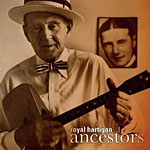 Royal Hartigan
Royal HartiganAncestors
Innova
2010
Ancestors reflects a universal viewpoint without being neatly categorized as world music. Ancestors was born out of Hartigan's sense of loss. It is a catharsis without closure and an acutely personal exploration of life, death, afterlife, and, mostly, family, in the immediate and universal sense. "Flight/Homecoming" opens the set with saxophonist Hafez Modirzadeh covering a spectrum of emotions, including keening a brief mourning. Baomi's wordless vocal improvisation continues the theme of movement and transition before Modirzadeh returns to transport the vocalist to a spoken word suite reaffirming the continuous cycle of life beyond the physical form. Hartigan alternately augments and drives the music throughout this opening segment, using bells, dondo, bass drum, and hi-hat before moving to the piano.
Within the two-disc set, Hartigan's own family emerges as a Greek Chorus. A poem by his grandfather is carried by Sandra Poindexter's poignant violin work, while Hartigan's tap-danced "Waltz Clog" is a tribute to both his uncle and mother and in a much lighter vein. Pop standards of past generations and Tchaikovsky's "Violin Concerto," appear as favorites of Hartigan's parents, adding personal insight amid more multicultural styles.
Haritgan is masterful at tying complex themes into a story, but more than that, he brilliantly conveys human emotion through the music. Ancestors accepts sadness and loss as a reality and celebrates ongoing rebirth, and treat time as an elastic continuum. Musically, he manages to incorporate instruments and styles as diverse as stride piano, Turkish bendir, and Chinese zither in a collected work that is both universal and tangible at the same time. Ancestors is a blend of musicology and genealogy that is unique and memorable.
CD1: Flight/Homecoming; Passages; Three Views; Hazel's Dance; Guanshan Yue; James Eagle Eye; La Vie En Rose/All to Myself/Soliloquy; Waltz Clog; Tenderly; Tatao; The Shadow of Your Smile; Cycles; Railroad Banjo To My Heart; Our Family; You'll Never Know Just How Much I Love You; Adzohu Kadodo Reflections. CD2: Hazel's Dance: Orphan Annie; Midnight Sun; Ray Hart; Parting Veil; Syrinx; We'll Be Together Again; New York Rhythm; Meng Jiang Nu; It Had To Be You; Tchaikovsky Violin Concerto In D Major/Midnight; In Moscow; Hanabi; I Know I've Been Changed; Tenderly; Dondo—Tap Conversation For Frank, Edward, Mary & Richie Hartigan; Divine Trance; Five Foot Two; Through The Light; Walking Step.
Baomi: vocals and narrative poetry; Conrad Benedicto: philippine dabakan drum; yu fuhua: violin; Danongan Kalanduyan: philippine kulintang gongs; Masaru Koga: Japanese shakuhachi flute; C. K. Ladzekpo: West African e e atsime u master drum, dondo hourglass drum; Hafez Modirzadeh; soprano and tenor saxophones, Persian ney flute, and western flute; Sandra Poindexter: violin; Timothy Volpicella: banjo; Weihua Zhang: Chinese guzheng zither; Royal Hartigan: bells, percussion, piano, tap dance, Turkish bendir frame drum, axatse gourd rattle, dondo hourglass drum, drum set.
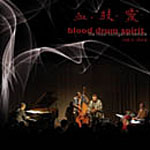 Royal Hartigan
Royal HartiganBlood Drum Spirit: Royal Hartigan Ensemble Live in China
Innova
2010
Recorded in Beijing, Blood Drum Spirit: Royal Hartigan Ensemble Live in China is the third of a trilogy but includes changes from the original studio namesake. Guitarist Kevin McNeal is replaced by pianist Art Hirahara, giving the quartet a bit more punch. The first Blood Drum Spirit (Innova, 2004) entry consisted almost entirely of original compositions, other than a snippet of Duke Ellington's "Caravan." This two-disc live set features covers by artists including Ellington, Charles Mingus, Sonny Rollins and Dizzy Gillespie. What remains consistent throughout the entire trilogy is that drummer Hartigan's work is always a fascinating historical investigation of ethnic musical influences as a means of expression.
Ethnicity aside, Live in China is the most straight-ahead jazz collection in the trilogy. Much of this due to Hirahara and saxophonist David Bindman—each contributing several tracks and providing a solid presence throughout. At almost seventeen minutes, the set opens with Bindman's "Crisis in (Now's the) Time," which changes time signatures and styles and features an extended solo from Hartigan. This is followed by a medley of "Flowing Stream/Goodbye Pork Pie Hat," where a traditional Chinese song and Mingus' tribute to Lester Young feel at home with each other, thanks to Hafez Modirzadeh's arrangement.
Hartigan's arrangement of Gillespie's "A Night in Tunisia," opening with a solo from bassist Wes Brown, is faster than the original, features elements of rumba and swing and solos from everyone in the group. The 21-minute "Dreamsfireswaking/Invitation" opens and closes with drum solos over a group vamp. Again, there are frequent changes as the piece shifts from a relaxed pace to swing to West African and, once again, back to an Afro-Cuban rumba style. Hartigan and Bindman perform a duet before the saxophonist takes a solo and the group then rounds things out. It is the kind of complex setting in which this group excels.
CD1: Crisis In (Now's the) Time; Flowing Stream/Goodbye Porkpie Hat; Threads; In a Sentimental Mood; A Night in Tunisia; Song for Your Return; Dreamfireswaking/Invitation. CD2: Anlo Kete; Peace, Unknown; Gati Shadows Within; High Definition Truth; Oleo; Hazel Clark Asante Adowa/ Generations Suite; Owl's Nightmare; We'll Be Together Again; Tenderly.
David Bindman: tenor saxophone; Wes Brown: bass; Art Hirahara: piano; Royal Hartigan: drums.
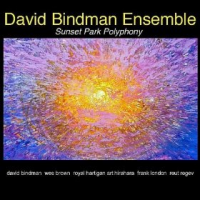 David Bindman Ensemble
David Bindman EnsembleSunset Park Polyphony
Self Produced
2012
Jazz has been at the forefront of the cultural renewal in Brooklyn, and saxophonist David Bindman has been a quiet but leading force in that movement. Sunset Park Polyphony brings together members of the stellar quartet that last recorded under the leadership of percussionist Royal Hartigan on Blood Drum Spirit: Royal Hartigan Ensemble Live in China (Innova, 2008), with Bindman extending the original group to a sextet with the addition of trombonist Reut Regev and trumpeter Frank London. The addition of these two horns gives the ensemble a different feel, as the sound alternates between lush and powerful.
Those familiar with Bindman's previous work with saxophonist Fred Ho, bassist Joe Fonda and his Brooklyn Sax Quartet know that he is very adept as an improviser. The free jazz approach plays a somewhat more significant part in Sunset Park Polyphony, compared to Bindman's prior work with Hartigan. Bindman and the ensemble imbue the spirit of enjoyment even as they adhere to an implication of social responsibility. They relate stories that are held together by collective musical memories. The ensemble's wide range of cultural appreciation is not a euphemism for world music. This is exceptionally creative jazz, at times played with great subtlety and sometimes with wild abandon.
CD1: Shape One; Long Line Home; Sunset Park Polyphony; Robeson House Echoes. CD2: The Transient; Singing Bird Melody; Icarus Flies Towards the Sun and Returns; Invisible Dance; Singing Bird Reprise; Recurring Dream; Unspoken; Robeson House Reprise.
David Bindman: tenor saxophone; Wes Brown: bass; Art Hirahara: piano; Royal Hartigan: drums; Frank London: trumpet; Reut Regev: trombone.
 Royal Hartigan & Blood Drum Spirit
Royal Hartigan & Blood Drum SpiritTime Changes
Self Produced
2019
Hartigan's ties to the drumming culture of West Africa are indestructible. So too are his bonds to the people he has lived with on and off for years; people who have experienced famine, homelessness and genocide in post-colonial struggles for self-determination. The region's music reflects circumstances that encompass everyday tasks, ceremonies, simple pleasures, and ongoing pain.
West Africa's inspirations are felt in the traditional rhythmic creations "Bewaa" and "Circle of Creation/Adzohu Suite" based on the dance drumming of the Dagara and Ewe peoples of the region. The quartet puts unique spins on standards such as Eddie Harris' "Freedom Jazz Dance," John Coltrane's "Naima," "St. Louis Blues " and "Lift Every Voice and Sing." It's always a pleasure to hear Hartigan solo, and on Time Changes the master drummer takes over on five tracks—"Drum Solo for Mr. Adams, Mr. McBrowne, Mr. Roach, Mr. Jarvis," "Fontomfrom Suite," "Dancing on the Drums," "Penteng" and "Blues for Mister Charlie and Miss Ann."
Whether the band is covering classics, improvising original pieces, or interpreting the drum dancing music, the aesthetic is almost always rooted in West Africa. "We Are One!" is a companion piece movie that goes behind the scenes with the group in Dartmouth, Massachusetts, and Ghana. A dance teacher in the Asanti region relates "You cannot detach our dances from who we are, the dances tell a story. The dance itself is the culture." Time Changes relates those stories in a variety of styles and is compelling listening throughout.
Disc 1: Hits; Donno Ntoaso; Freedom Dance; The Betrayal; Drum Solo for Mr. Adams, Mr. McBrowne, Mr. Roach, Mr. Jarvis, Mr. Blackwell; James and Hazel; Bewaa; Silent Spaces; If Only.........; Fontomfrom Suite; Naima. Disc 2: Circle of Creation / Adzohu Suite; Dancing on the Drums; Longing (A Boy and a Beauty); Penteng; The Look; Blues for Mister Charlie and Miss Ann; St. Louis Blues; Lift Every Voice and Sing; Syrinx; High Fly.
David Bindman: tenor and soprano saxophones, flute; Wes Brown: contrabass; Art Hirahara: piano; Royal Hartigan: drum set, donno, hourglass drum.
Tags
PREVIOUS / NEXT
Support All About Jazz
 All About Jazz has been a pillar of jazz since 1995, championing it as an art form and, more importantly, supporting the musicians who make it. Our enduring commitment has made "AAJ" one of the most culturally important websites of its kind, read by hundreds of thousands of fans, musicians and industry figures every month.
All About Jazz has been a pillar of jazz since 1995, championing it as an art form and, more importantly, supporting the musicians who make it. Our enduring commitment has made "AAJ" one of the most culturally important websites of its kind, read by hundreds of thousands of fans, musicians and industry figures every month.


